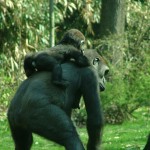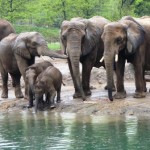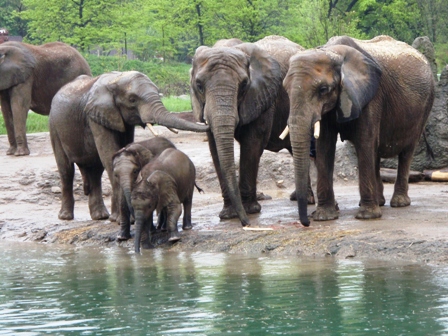 In honor of Valentine’s Day, I thought it only fitting to take a closer look at baby making, and rearing, in the animal kingdom. Being a reproductive physiologist by training, I am always very fascinated by the ways wildlife have adapted to ensure species survival. How animals have evolved to overcome harsh environments, predators, and lack of resources, to name a few, to reproduce and raise young is incredible to say the very least.
In honor of Valentine’s Day, I thought it only fitting to take a closer look at baby making, and rearing, in the animal kingdom. Being a reproductive physiologist by training, I am always very fascinated by the ways wildlife have adapted to ensure species survival. How animals have evolved to overcome harsh environments, predators, and lack of resources, to name a few, to reproduce and raise young is incredible to say the very least.
Thanks to the children’s animated feature, Happy Feet, most of us have at least a basic understanding of the  yearly mating and egg laying drama of the Emperor penguin. Living in the harshest climate on the planet, Emperor penguins travel to Antarctica to raise their families. After courtship and mating, the female lays a single egg. Because of below freezing temperatures, the egg must rest on the tops of the mother’s feet. Not too long after laying, the egg is transferred from the mother to the father. Many eggs are lost in this Ova-repositioning dance. Once the egg is safely on the father’s feet the females head out to sea to feed for the following few months, leaving the fathers to endure temperatures of -40 degrees C, winds close to 200 km per hour, and without food. In fact, during this ordeal, the male can lose up to 50% of his total body weight. Fathers continue to look after their precious cargo for approximately 64 days until the egg hatches. Usually, at this time or shortly after, the females return and take over feeding and protection of the chick allowing the new fathers a well-deserved vacation at sea.
yearly mating and egg laying drama of the Emperor penguin. Living in the harshest climate on the planet, Emperor penguins travel to Antarctica to raise their families. After courtship and mating, the female lays a single egg. Because of below freezing temperatures, the egg must rest on the tops of the mother’s feet. Not too long after laying, the egg is transferred from the mother to the father. Many eggs are lost in this Ova-repositioning dance. Once the egg is safely on the father’s feet the females head out to sea to feed for the following few months, leaving the fathers to endure temperatures of -40 degrees C, winds close to 200 km per hour, and without food. In fact, during this ordeal, the male can lose up to 50% of his total body weight. Fathers continue to look after their precious cargo for approximately 64 days until the egg hatches. Usually, at this time or shortly after, the females return and take over feeding and protection of the chick allowing the new fathers a well-deserved vacation at sea.
 In stark contrast, male elephants participate in the making of the young, but not much else. Elephant herds are made up of mothers, sisters, aunts, nieces, grandmothers, and juvenile males, all of which participate in rearing young calves. I believe the old African proverb “It takes a village to raise a child” was written about elephant society. After a 22 month gestation, female elephants give birth to an almost 100 kg calf. Like all things elephant, nothing is done quickly; thus, elephant babies continue to nurse for 3-4 years. Although it sounds like a lot of work for mom, she has an incredible support system within the herd. Prepubertal females learn how to take care of calves by babysitting younger siblings and cousins. Older females no longer having young of their own participate in a grandmother-like behavior know as allomothering. Thus, mothers are given a break to forage while their calves are well cared for by others.
In stark contrast, male elephants participate in the making of the young, but not much else. Elephant herds are made up of mothers, sisters, aunts, nieces, grandmothers, and juvenile males, all of which participate in rearing young calves. I believe the old African proverb “It takes a village to raise a child” was written about elephant society. After a 22 month gestation, female elephants give birth to an almost 100 kg calf. Like all things elephant, nothing is done quickly; thus, elephant babies continue to nurse for 3-4 years. Although it sounds like a lot of work for mom, she has an incredible support system within the herd. Prepubertal females learn how to take care of calves by babysitting younger siblings and cousins. Older females no longer having young of their own participate in a grandmother-like behavior know as allomothering. Thus, mothers are given a break to forage while their calves are well cared for by others.
A new take on pregnancy can be seen in any of the 32 species of seahorse. After an intricate courtship dance that may be performed over several days, the female deposits as many as 2,000 eggs in a pouch located on the male’s stomach. Once inside the pouch, the eggs are fertilized. After 10-25 days, neonates hatch but remain in the pouch. Slowly, the father regulates the salinity inside the pouch acclimating young for life in the ocean. When the young are in the fry stage they are expelled from their father’s pouch via muscle contractions similar to those experienced in parturition in females of other species. However, after the baby seahorses are born, they are on their own.
that may be performed over several days, the female deposits as many as 2,000 eggs in a pouch located on the male’s stomach. Once inside the pouch, the eggs are fertilized. After 10-25 days, neonates hatch but remain in the pouch. Slowly, the father regulates the salinity inside the pouch acclimating young for life in the ocean. When the young are in the fry stage they are expelled from their father’s pouch via muscle contractions similar to those experienced in parturition in females of other species. However, after the baby seahorses are born, they are on their own.
Adaptions in reproduction processes, including mating, pregnancy, and rearing of young, has facilitated species survival. Whether it be parturition by a father instead of mother, or an extended gestation and lactation period, wildlife are quite successful in all matters of love and baby making. To fill their niche, species have evolved to handle family rearing in harsh environments, with or without help. So this Valentine’s Day when you are either giving or receiving the reproductive organs of angiosperms (surely you didn’t think flowers were simply used for aesthetical purposes) to your loved one, give a small pause for other members of the animal kingdom. For them, love in the air is more then wine and chocolates, for some it is about sacrifice and true devotion.
